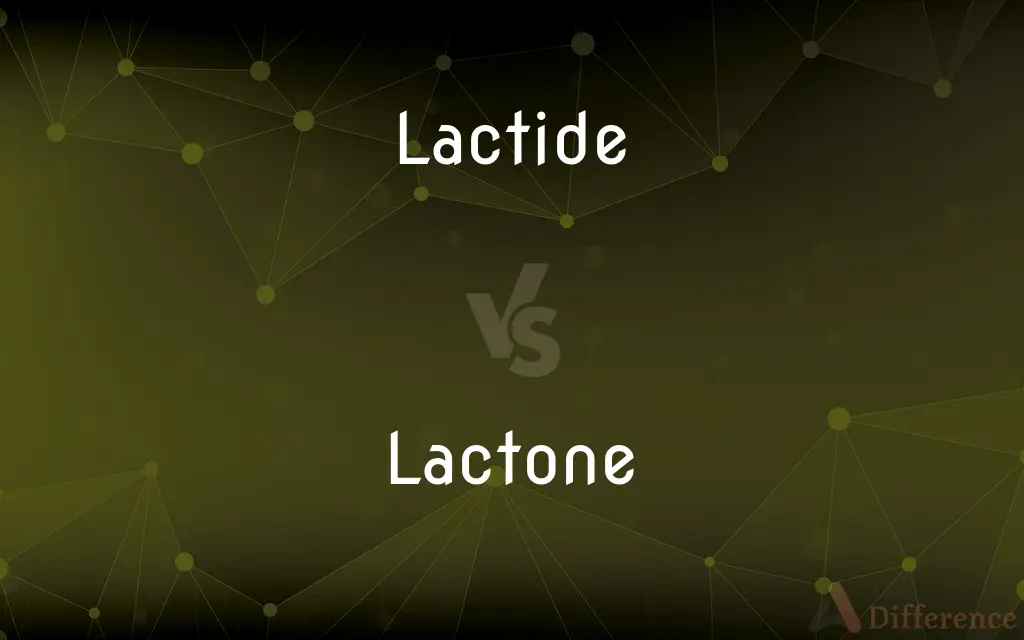Lactide vs. Lactone — What's the Difference?
By Tayyaba Rehman & Urooj Arif — Published on March 8, 2024
Lactide is a cyclic di-ester formed from two lactic acid molecules, often used in polylactic acid (PLA) production. Lactone is a broader category of cyclic esters formed from hydroxy acids, with varied applications in flavors and pharmaceuticals.

Difference Between Lactide and Lactone
Table of Contents
ADVERTISEMENT
Key Differences
Lactide specifically refers to the cyclic di-ester derived from the condensation of two lactic acid molecules, a key intermediate in the production of polylactic acid (PLA), a biodegradable polymer. Lactone, on the other hand, denotes any cyclic ester formed by the intramolecular esterification of a hydroxy acid, encompassing a wide range of compounds with diverse structures and applications.
Lactide is crucial in the synthesis of PLA, a sustainable alternative to petrochemical-derived plastics, highlighting its importance in environmental conservation and sustainable manufacturing. Lactones are widely used in the pharmaceutical and food industries due to their aromatic and flavor-enhancing properties, indicating their versatility and significance in various sectors.
The formation of lactide involves a dehydration reaction of lactic acid, showcasing the specific chemical process it undergoes. In contrast, lactones can be formed through various reactions, depending on the hydroxy acid involved, demonstrating the broader chemical diversity within lactones.
Lactide's use is primarily industrial, focused on PLA production for packaging, textiles, and biomedical devices, underscoring its role in material science and engineering. Lactones have broader applications, from serving as key flavor components in foods and beverages to acting as building blocks in pharmaceutical synthesis, reflecting their widespread utility.
Comparison Chart
Definition
A cyclic di-ester from two lactic acid molecules.
A cyclic ester formed from hydroxy acids.
ADVERTISEMENT
Primary Use
Production of polylactic acid (PLA).
Used in flavors, fragrances, and pharmaceuticals.
Formation
Dehydration reaction of lactic acid.
Intramolecular esterification of a hydroxy acid.
Chemical Nature
Specific structure derived from lactic acid.
Broad category with diverse structures.
Applications
Industrial, mainly in biodegradable plastics.
Versatile, ranging from food flavoring to medicine.
Compare with Definitions
Lactide
Lactide is a cyclic di-ester used in making biodegradable plastics.
Lactide is synthesized for PLA production, a sustainable packaging material.
Lactone
Lactone refers to cyclic esters from hydroxy acids.
γ-Butyrolactone is a lactone used in making various pharmaceuticals.
Lactide
It forms through condensation of two molecules of lactic acid.
The production of lactide involves removing water from lactic acid.
Lactone
They vary widely in size and complexity.
Simple lactones are used in foods, while complex ones are found in antibiotics.
Lactide
Lactide is a key intermediate in biopolymer manufacturing.
Industrial processes convert lactide into polylactic acid for biodegradable products.
Lactone
Lactones have applications in pharmaceuticals.
Some lactones are key intermediates in synthesizing anticancer drugs.
Lactide
Lactide contributes to sustainable materials science.
Using lactide in production emphasizes a commitment to green manufacturing practices.
Lactone
Lactones are common in flavors and fragrances.
Peach and coconut aromas are due to lactones.
Lactide
It is biodegradable and derived from renewable resources.
Lactide-based products decompose naturally, reducing environmental impact.
Lactone
It is characterized by its ring structure.
Lactones form when a carboxylic acid reacts with an alcohol in the same molecule.
Lactide
(organic chemistry) Any of a class of heterocyclic compounds, formally acid anhydrides, formed by heating α-lactones
Lactone
A cyclic ester, or a compound containing a cyclic ester, formed by the intramolecular condensation of a hydroxy carboxylic acid.
Lactide
(organic compound) The anhydride of lactic acid
Lactone
(organic chemistry) A cyclic intramolecular ester derived from a hydroxy acid
Lactide
A white, crystalline substance, obtained from lactic acid by distillation, and regarded as an anhydride; also, by extension, any similar substance.
Lactone
One of a series of organic compounds, being cyclic esters which may be regarded as anhydrides of certain hydroxy acids. In general, they are colorless liquids, having a weak aromatic odor. They are so called because the typical lactone is derived from lactic acid.
Common Curiosities
Are all lactones sweet?
Not all lactones are sweet; their taste varies widely depending on their structure.
Is PLA made from lactone?
PLA is not made directly from lactones but from lactide, a specific type of cyclic di-ester.
What is lactide used for?
Lactide is primarily used in the production of polylactic acid (PLA), a biodegradable polymer.
Can lactide be found naturally?
Lactide is not found naturally; it is synthesized from lactic acid, which is naturally occurring.
What distinguishes lactide from other lactones?
Lactide is specifically derived from lactic acid, while lactones can come from any hydroxy acid.
Are lactides biodegradable?
Yes, lactides are used to make PLA, which is biodegradable.
How are lactones formed?
Lactones are formed through the intramolecular esterification of hydroxy acids.
Do lactones have medical applications?
Yes, some lactones are used in pharmaceuticals, including anticancer and antibiotic drugs.
What is the significance of lactide in sustainable manufacturing?
Lactide's role in producing PLA highlights its contribution to reducing reliance on fossil fuels and promoting biodegradability.
How does the structure of lactones affect their use?
The diverse structures of lactones determine their use in various industries, from food flavoring to pharmaceuticals.
Are lactones present in all foods?
Not all foods contain lactones, but they are common in many fruits and fermented products.
Can lactones be synthetic?
Yes, lactones can be both naturally occurring and synthetically produced.
Is lactide safe for food contact?
Yes, PLA derived from lactide is considered safe for food contact applications.
Can lactide be used in medical devices?
Yes, PLA made from lactide is used in biodegradable medical implants and devices.
What makes lactones unique in chemistry?
Lactones' unique cyclic ester structure allows for a wide range of chemical properties and applications.
Share Your Discovery

Previous Comparison
Isopropyl Alcohol vs. Denatured Alcohol
Next Comparison
AC Charger vs. DC ChargerAuthor Spotlight
Written by
Tayyaba RehmanTayyaba Rehman is a distinguished writer, currently serving as a primary contributor to askdifference.com. As a researcher in semantics and etymology, Tayyaba's passion for the complexity of languages and their distinctions has found a perfect home on the platform. Tayyaba delves into the intricacies of language, distinguishing between commonly confused words and phrases, thereby providing clarity for readers worldwide.
Co-written by
Urooj ArifUrooj is a skilled content writer at Ask Difference, known for her exceptional ability to simplify complex topics into engaging and informative content. With a passion for research and a flair for clear, concise writing, she consistently delivers articles that resonate with our diverse audience.
















































